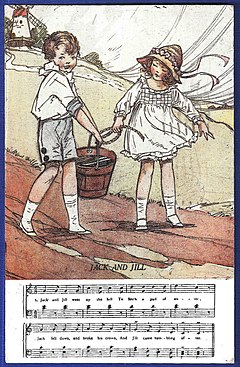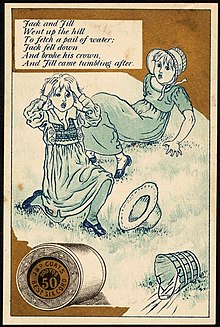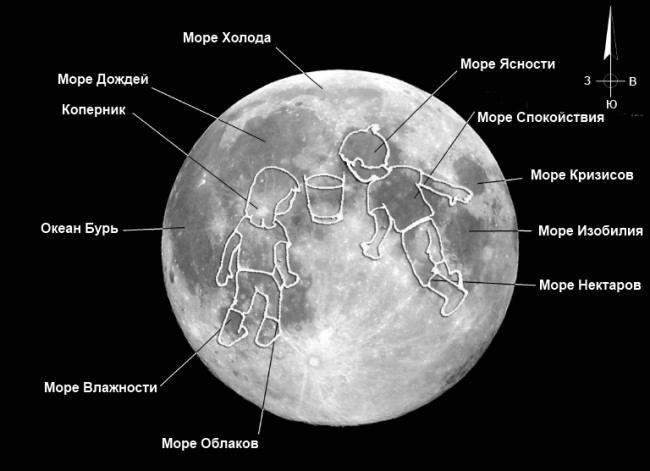«Jack and Jill» (sometimes «Jack and Gill«, particularly in earlier versions) is a traditional English nursery rhyme. The Roud Folk Song Index classifies the commonest tune and its variations as number 10266,[1] although it has been set to several others. The original rhyme dates back to the 18th century and different numbers of verses were later added, each with variations in the wording. Throughout the 19th century new versions of the story were written featuring different incidents. A number of theories continue to be advanced to explain the rhyme’s historical origin.
Text[edit]
From Mother Goose’s Melody (1791 edition)
The earliest version of the rhyme was in a reprint of John Newbery’s Mother Goose’s Melody, thought to have been first published in London around 1765.[2] The rhyming of «water» with «after» was taken by Iona and Peter Opie to suggest that the first verse might date from the 17th century.[3] Jill was originally spelled Gill in the earliest version of the rhyme and the accompanying woodcut showed two boys at the foot of the hill.
Jack and Gill went up the hill
To fetch a pail of water;
Jack fell down and broke his crown
And Gill came tumbling after.
Later the spelling was changed to Jill and more verses were added to carry the story further, of which the commonest are:
Up Jack got and home did trot,
As fast as he could caper;
Went to bed to mend his head
With vinegar and brown paper.Jill came in and she did grin
To see his paper plaster;
Mother, vex’d, did whip her next
For causing Jack’s disaster.[4]
As presented over the following century, the rhyming scheme of the six-line stanzas is AABCCB and they are trochaic in rhythm. Alternatively, when given the form of internally rhymed quatrains, this would be an example of the ballad form commonly used for nursery rhymes.[5]
The phrase «Jack and Jill» existed earlier in England to indicate a boy and girl as a generic pair. It is so used, for example, in the proverb «Every Jack (shall/must) have his Jill»,[6] to which there are references in two plays by William Shakespeare dating from the 1590s.[7] The compress of vinegar and brown paper to which Jack resorted after his fall was a common home cure used to heal bruises.[8]
New versions[edit]
Though approximately the words above are what have survived of the nursery rhyme to the present, their sense is preserved at the start of a 15-stanza chapbook, Jack & Jill and Old Dame Gill, published in 1806. The work dates from the period when children’s literature was beginning to shift from instruction to fun in the wake of the success of Old Mother Hubbard and kindred works.[9] This change of emphasis was signalled by the book’s coloured illustrations and introductory epigraph: «Read it who will, They’ll laugh their fill». In this version the trio of Jack, Jill, and their mother Dame Gill experience further mishaps involving the dog Ball, an attack from a goat, falls from a see-saw, a swing and a pig, followed by a parental whipping for getting dirty.[10] Many pirated editions of the work followed from both London and provincial presses, accompanied by black and white as well as coloured woodcuts. Sometimes there were several different editions from the same press, such as, for example, the Banbury editions of John Golby Rusher (1784–1877) between 1835–1845. The wording also varied in these, and there were multiplications of the creatures involved in the adventures of the three protagonists – a donkey, a reindeer, a bull, a goose and a camel.[11]
An advertising card based on Kate Greenaway’s 1881 illustration of the rhyme
As the decades advanced there were changes in form as well as wording. An 1840s edition from Otley, titled The adventures of Jack & Jill and old Dame Jill, was written in longer and more circumstantial quatrains of between ten and twelve syllables, rhymed AABB.[12] Among other changes in the poem, Jack’s injuries are treated, not with vinegar and brown paper, but «spread all over with sugar and rum».
There were also radical changes in the telling of the story in America. Among the Juvenile Songs rewritten and set to music by Fanny E. Lacy (Boston 1852) was a six-stanza version of Jack and Jill. Having related their climb and fall from the hill, the rest of the poem is devoted to a warning against social climbing: «By this we see that folks should be/ Contented with their station,/ And never try to look so high/ Above their situation.»[13] There is a similar tendency to moral instruction in the three «chapters» of Jack and Jill, for old and young by Lawrence Augustus Gobright (1816–1879), published in Philadelphia in 1873. There the pair have grown up to be a devoted and industrious married couple; the fall is circumstantially explained and the cure afterwards drawn out over many, many quatrains.[14] In the introduction to his work, Gobright makes the claim that the two-stanza version of the original nursery rhyme was, in earlier editions, followed by two more:
Little Jane ran up the lane
To hang her clothes a-drying;
She called for Nell to ring the bell,
For Jack and Jill were dying.
Nimble Dick ran up so quick,
He tumbled over a timber,
And bent his bow to shoot a crow,
And killed a cat in the window.
No such verses are found in English editions, although they do appear in a later American edition of Mother Goose’s nursery rhymes, tales and jingles (New York 1902).[15]
Yet another American variation on the story appeared in the Saint Nicholas Magazine. This was Margaret Johnson’s «A New Jack and Jill», in which the brother and sister constantly return with an empty bucket because they have not noticed that there is a hole in it.[16] Clifton Bingham (1859–1913) followed it with «The New Jack and Jill», which appeared in the children’s album Fun and Frolic (London and New York, 1900), illustrated by Louis Wain.[17] Here there is a return to the six-line stanza form:
Jack and Jill
Went up the hill
To fetch a pail of milk, oh!
Jack was drest
In his Sunday best,
And Jill in her gown of silk, oh!
But the cow objects and chases them down again. The exclamatory style used in all three stanzas replicates that used only in the sixth stanza of the popular Jack and Jill and Old Dame Gill.
Musical settings[edit]
Musical setting by Charles Burney (1777)
A musical arrangement of the rhyme as a catch by Charles Burney was published in 1777, at a date earlier than any still existing copy of Mother Goose’s Melody.[18] But the melody commonly associated with the rhyme was first recorded with the three stanza version by the composer and nursery lore collector James William Elliott in his National Nursery Rhymes and Nursery Songs (1870),[19] which was published in America as Mother Goose Set to Music the following year.[20] And in 1877 the single-stanza version illustrated by Walter Crane appeared in The Baby’s Opera (London 1877), which described itself as «a book of old rhymes in new dresses, the music by the earliest masters».[21]
The Victorian composer Alfred James Caldicott, who distinguished himself by setting several nursery rhymes as ingenious part songs, adapted «Jack and Jill» as one in 1878. These works were described by the Dictionary of National Biography as a «humorous admixture of childish words and very complicated music…with full use of contrast and the opportunities afforded by individual words».[22] Among American adaptations of his work for female voices, there were settings by E. M. Bowman (New York, 1883)[23] and Charles R. Ford (Boston, 1885).[24] In Canada, Spencer Percival was responsible for a part-song of his own for four voices, first performed in 1882.[25][26]
Sigmund Spaeth was eventually to have fun with the rhyme by adapting it to a number of bygone musical styles as The musical adventures of Jack & Jill in Words & Music: A Book of Burlesques, (Simon and Schuster, 1926). These included a Handel aria, Italian operatic and Wagnerian versions.[27] Later on the English composer Geoffrey Hartley (1906–1992) set the original as a chamber piece for horn and two bassoons, or for wind trio (1975), and later reset it as a bassoon trio.[28]
Interpretations[edit]
The plaque erected in 2000 at Kilmersdon to commemorate the village’s association with the rhyme
There are several theories concerning the origin of the rhyme. Most such explanations postdate the first publication of the rhyme and have no corroborating evidence. S. Baring-Gould suggested that the rhyme is related to a story in the 13th-century Icelandic Gylfaginning in which the brother and sister Hjuki and Bil were stolen by the Moon while drawing water from a well, to be seen there to this day.[29]
Other suggestions rooted in history include a reference to the executions of Richard Empson and Edmund Dudley in 1510,[30] or to a marriage negotiation conducted by Thomas Wolsey in 1514.[31] Alternatively it has been taken to satirise the attempt by King Charles I of England to raise extra revenue by ordering that the volume of a Jack (1/8 pint) be reduced, while the tax remained the same. In consequence of this, the Gill (a quarter pint in liquid measure) «came tumbling after».[32]
There is also a belief in Somerset that the rhyme records events in the village of Kilmersdon when a local girl became pregnant; the putative father is said to have died from a rockfall and the woman afterwards died in childbirth. The local surname of Gilson is therefore taken to derive from Gill’s son.[33]
A more prosaic origin of the rhyme is suggested by historian Edward A. Martin, who notes that pails of water may readily have been collected from dew ponds, which were located on the tops of hills.[34]
See also[edit]
- List of nursery rhymes
Notes[edit]
- ^ «Searchable database», English Folk Song and Dance Society, retrieved 18 March 2012.
- ^ B. Cullinan and D. G. Person, The Continuum Encyclopedia of Children’s Literature (London: Continuum, 2003), ISBN 0-8264-1778-7, p. 561.
- ^ The Oxford Dictionary of Nursery Rhymes, OUP 1997, pp.265-7
- ^ National Nursery Rhymes and Nursery Songs, London 1871, pp.2-3
- ^ L. Turco, The Book of Forms: a Handbook of Poetics (Lebanon, NH: University Press of New England, 3rd edn., 2000), ISBN 1-58465-022-2, pp. 28–30.
- ^ William George Smith, The Oxford Dictionary of English Proverbs, (OUP 1935) p.95
- ^ In A Midsummer Night’s Dream (III:ii:460-2, «Jack shall have Jill») and in Love’s Labour’s Lost (V:ii:874–5, «Jack hath not Jill»)
- ^ Gabrielle Hatfield, Encyclopedia of Folk Medicine, ABC Clio 2004, p.187
- ^ Delaney, Lesley Jane: «‘Making amusement the vehicle of instruction’: Key Developments in the Nursery Reading Market 1783-1900», UCL PhD thesis, 2012, p.105 — 120
- ^ Reproduced in the Public Domain Review
- ^ University of Washington
- ^ An example preserved in McGill Library
- ^ A copy at Johns Hopkins University
- ^ See the digitized Library of Congress copy at the Internet Archive
- ^ Edited by W. Gannon, copy available at the Internet Archive, pp.374-6
- ^ St Nicholas Magazine’ for young folks, January 1884, pp.238-9
- ^ The University of Michigan’s digitized version, pp.50-51
- ^ Arnold, John, ed. (1777). The Essex Harmony. Vol. ii (second ed.). London: J. Buckland and S. Crowder. p. 130.
- ^ University of Florida, pp.2-3
- ^ Google Books
- ^ Available at Gutenberg, pp.52-3
- ^ DNB entry for «Caldicott, Alfred James» in the 1901 supplement
- ^ Library of Congress
- ^ Library of Congress
- ^ McGill University
- ^ A modern performance on Good Night, Good Night, Beloved! and other Victorian part songs, Atma Classique 2012
- ^ Google Books, pp.15-34
- ^ Trevco Varner Music
- ^ Elizabeth Knowles, The Oxford Dictionary of Phrase and Fable (OUP 2000), «Jack and Jill»
- ^ Elizabeth Knowles, The Oxford Dictionary of Phrase and Fable (OUP 2000), «Jack and Jill»
- ^ W. S. Baring-Gould and C. Baring Gould, The Annotated Mother Goose (Bramhall House, 1962), ISBN 0-517-02959-6, pp. 60–62.
- ^ Albert Jack, Pop Goes the Weasel: The Secret Meanings of Nursery Rhymes, Penguin 2008, «Jack and Jill»
- ^ Laura Lee, The Name’s Familiar, Pelican 1999, pp.139-40
- ^ Martin, Edward A. (September 1930). «Dew-Ponds». Antiquity. 4 (15): 347–351. doi:10.1017/S0003598X00004932.
External links[edit]
«Jack and Jill» (sometimes «Jack and Gill«, particularly in earlier versions) is a traditional English nursery rhyme. The Roud Folk Song Index classifies the commonest tune and its variations as number 10266,[1] although it has been set to several others. The original rhyme dates back to the 18th century and different numbers of verses were later added, each with variations in the wording. Throughout the 19th century new versions of the story were written featuring different incidents. A number of theories continue to be advanced to explain the rhyme’s historical origin.
Text[edit]
From Mother Goose’s Melody (1791 edition)
The earliest version of the rhyme was in a reprint of John Newbery’s Mother Goose’s Melody, thought to have been first published in London around 1765.[2] The rhyming of «water» with «after» was taken by Iona and Peter Opie to suggest that the first verse might date from the 17th century.[3] Jill was originally spelled Gill in the earliest version of the rhyme and the accompanying woodcut showed two boys at the foot of the hill.
Jack and Gill went up the hill
To fetch a pail of water;
Jack fell down and broke his crown
And Gill came tumbling after.
Later the spelling was changed to Jill and more verses were added to carry the story further, of which the commonest are:
Up Jack got and home did trot,
As fast as he could caper;
Went to bed to mend his head
With vinegar and brown paper.Jill came in and she did grin
To see his paper plaster;
Mother, vex’d, did whip her next
For causing Jack’s disaster.[4]
As presented over the following century, the rhyming scheme of the six-line stanzas is AABCCB and they are trochaic in rhythm. Alternatively, when given the form of internally rhymed quatrains, this would be an example of the ballad form commonly used for nursery rhymes.[5]
The phrase «Jack and Jill» existed earlier in England to indicate a boy and girl as a generic pair. It is so used, for example, in the proverb «Every Jack (shall/must) have his Jill»,[6] to which there are references in two plays by William Shakespeare dating from the 1590s.[7] The compress of vinegar and brown paper to which Jack resorted after his fall was a common home cure used to heal bruises.[8]
New versions[edit]
Though approximately the words above are what have survived of the nursery rhyme to the present, their sense is preserved at the start of a 15-stanza chapbook, Jack & Jill and Old Dame Gill, published in 1806. The work dates from the period when children’s literature was beginning to shift from instruction to fun in the wake of the success of Old Mother Hubbard and kindred works.[9] This change of emphasis was signalled by the book’s coloured illustrations and introductory epigraph: «Read it who will, They’ll laugh their fill». In this version the trio of Jack, Jill, and their mother Dame Gill experience further mishaps involving the dog Ball, an attack from a goat, falls from a see-saw, a swing and a pig, followed by a parental whipping for getting dirty.[10] Many pirated editions of the work followed from both London and provincial presses, accompanied by black and white as well as coloured woodcuts. Sometimes there were several different editions from the same press, such as, for example, the Banbury editions of John Golby Rusher (1784–1877) between 1835–1845. The wording also varied in these, and there were multiplications of the creatures involved in the adventures of the three protagonists – a donkey, a reindeer, a bull, a goose and a camel.[11]
An advertising card based on Kate Greenaway’s 1881 illustration of the rhyme
As the decades advanced there were changes in form as well as wording. An 1840s edition from Otley, titled The adventures of Jack & Jill and old Dame Jill, was written in longer and more circumstantial quatrains of between ten and twelve syllables, rhymed AABB.[12] Among other changes in the poem, Jack’s injuries are treated, not with vinegar and brown paper, but «spread all over with sugar and rum».
There were also radical changes in the telling of the story in America. Among the Juvenile Songs rewritten and set to music by Fanny E. Lacy (Boston 1852) was a six-stanza version of Jack and Jill. Having related their climb and fall from the hill, the rest of the poem is devoted to a warning against social climbing: «By this we see that folks should be/ Contented with their station,/ And never try to look so high/ Above their situation.»[13] There is a similar tendency to moral instruction in the three «chapters» of Jack and Jill, for old and young by Lawrence Augustus Gobright (1816–1879), published in Philadelphia in 1873. There the pair have grown up to be a devoted and industrious married couple; the fall is circumstantially explained and the cure afterwards drawn out over many, many quatrains.[14] In the introduction to his work, Gobright makes the claim that the two-stanza version of the original nursery rhyme was, in earlier editions, followed by two more:
Little Jane ran up the lane
To hang her clothes a-drying;
She called for Nell to ring the bell,
For Jack and Jill were dying.
Nimble Dick ran up so quick,
He tumbled over a timber,
And bent his bow to shoot a crow,
And killed a cat in the window.
No such verses are found in English editions, although they do appear in a later American edition of Mother Goose’s nursery rhymes, tales and jingles (New York 1902).[15]
Yet another American variation on the story appeared in the Saint Nicholas Magazine. This was Margaret Johnson’s «A New Jack and Jill», in which the brother and sister constantly return with an empty bucket because they have not noticed that there is a hole in it.[16] Clifton Bingham (1859–1913) followed it with «The New Jack and Jill», which appeared in the children’s album Fun and Frolic (London and New York, 1900), illustrated by Louis Wain.[17] Here there is a return to the six-line stanza form:
Jack and Jill
Went up the hill
To fetch a pail of milk, oh!
Jack was drest
In his Sunday best,
And Jill in her gown of silk, oh!
But the cow objects and chases them down again. The exclamatory style used in all three stanzas replicates that used only in the sixth stanza of the popular Jack and Jill and Old Dame Gill.
Musical settings[edit]
Musical setting by Charles Burney (1777)
A musical arrangement of the rhyme as a catch by Charles Burney was published in 1777, at a date earlier than any still existing copy of Mother Goose’s Melody.[18] But the melody commonly associated with the rhyme was first recorded with the three stanza version by the composer and nursery lore collector James William Elliott in his National Nursery Rhymes and Nursery Songs (1870),[19] which was published in America as Mother Goose Set to Music the following year.[20] And in 1877 the single-stanza version illustrated by Walter Crane appeared in The Baby’s Opera (London 1877), which described itself as «a book of old rhymes in new dresses, the music by the earliest masters».[21]
The Victorian composer Alfred James Caldicott, who distinguished himself by setting several nursery rhymes as ingenious part songs, adapted «Jack and Jill» as one in 1878. These works were described by the Dictionary of National Biography as a «humorous admixture of childish words and very complicated music…with full use of contrast and the opportunities afforded by individual words».[22] Among American adaptations of his work for female voices, there were settings by E. M. Bowman (New York, 1883)[23] and Charles R. Ford (Boston, 1885).[24] In Canada, Spencer Percival was responsible for a part-song of his own for four voices, first performed in 1882.[25][26]
Sigmund Spaeth was eventually to have fun with the rhyme by adapting it to a number of bygone musical styles as The musical adventures of Jack & Jill in Words & Music: A Book of Burlesques, (Simon and Schuster, 1926). These included a Handel aria, Italian operatic and Wagnerian versions.[27] Later on the English composer Geoffrey Hartley (1906–1992) set the original as a chamber piece for horn and two bassoons, or for wind trio (1975), and later reset it as a bassoon trio.[28]
Interpretations[edit]
The plaque erected in 2000 at Kilmersdon to commemorate the village’s association with the rhyme
There are several theories concerning the origin of the rhyme. Most such explanations postdate the first publication of the rhyme and have no corroborating evidence. S. Baring-Gould suggested that the rhyme is related to a story in the 13th-century Icelandic Gylfaginning in which the brother and sister Hjuki and Bil were stolen by the Moon while drawing water from a well, to be seen there to this day.[29]
Other suggestions rooted in history include a reference to the executions of Richard Empson and Edmund Dudley in 1510,[30] or to a marriage negotiation conducted by Thomas Wolsey in 1514.[31] Alternatively it has been taken to satirise the attempt by King Charles I of England to raise extra revenue by ordering that the volume of a Jack (1/8 pint) be reduced, while the tax remained the same. In consequence of this, the Gill (a quarter pint in liquid measure) «came tumbling after».[32]
There is also a belief in Somerset that the rhyme records events in the village of Kilmersdon when a local girl became pregnant; the putative father is said to have died from a rockfall and the woman afterwards died in childbirth. The local surname of Gilson is therefore taken to derive from Gill’s son.[33]
A more prosaic origin of the rhyme is suggested by historian Edward A. Martin, who notes that pails of water may readily have been collected from dew ponds, which were located on the tops of hills.[34]
See also[edit]
- List of nursery rhymes
Notes[edit]
- ^ «Searchable database», English Folk Song and Dance Society, retrieved 18 March 2012.
- ^ B. Cullinan and D. G. Person, The Continuum Encyclopedia of Children’s Literature (London: Continuum, 2003), ISBN 0-8264-1778-7, p. 561.
- ^ The Oxford Dictionary of Nursery Rhymes, OUP 1997, pp.265-7
- ^ National Nursery Rhymes and Nursery Songs, London 1871, pp.2-3
- ^ L. Turco, The Book of Forms: a Handbook of Poetics (Lebanon, NH: University Press of New England, 3rd edn., 2000), ISBN 1-58465-022-2, pp. 28–30.
- ^ William George Smith, The Oxford Dictionary of English Proverbs, (OUP 1935) p.95
- ^ In A Midsummer Night’s Dream (III:ii:460-2, «Jack shall have Jill») and in Love’s Labour’s Lost (V:ii:874–5, «Jack hath not Jill»)
- ^ Gabrielle Hatfield, Encyclopedia of Folk Medicine, ABC Clio 2004, p.187
- ^ Delaney, Lesley Jane: «‘Making amusement the vehicle of instruction’: Key Developments in the Nursery Reading Market 1783-1900», UCL PhD thesis, 2012, p.105 — 120
- ^ Reproduced in the Public Domain Review
- ^ University of Washington
- ^ An example preserved in McGill Library
- ^ A copy at Johns Hopkins University
- ^ See the digitized Library of Congress copy at the Internet Archive
- ^ Edited by W. Gannon, copy available at the Internet Archive, pp.374-6
- ^ St Nicholas Magazine’ for young folks, January 1884, pp.238-9
- ^ The University of Michigan’s digitized version, pp.50-51
- ^ Arnold, John, ed. (1777). The Essex Harmony. Vol. ii (second ed.). London: J. Buckland and S. Crowder. p. 130.
- ^ University of Florida, pp.2-3
- ^ Google Books
- ^ Available at Gutenberg, pp.52-3
- ^ DNB entry for «Caldicott, Alfred James» in the 1901 supplement
- ^ Library of Congress
- ^ Library of Congress
- ^ McGill University
- ^ A modern performance on Good Night, Good Night, Beloved! and other Victorian part songs, Atma Classique 2012
- ^ Google Books, pp.15-34
- ^ Trevco Varner Music
- ^ Elizabeth Knowles, The Oxford Dictionary of Phrase and Fable (OUP 2000), «Jack and Jill»
- ^ Elizabeth Knowles, The Oxford Dictionary of Phrase and Fable (OUP 2000), «Jack and Jill»
- ^ W. S. Baring-Gould and C. Baring Gould, The Annotated Mother Goose (Bramhall House, 1962), ISBN 0-517-02959-6, pp. 60–62.
- ^ Albert Jack, Pop Goes the Weasel: The Secret Meanings of Nursery Rhymes, Penguin 2008, «Jack and Jill»
- ^ Laura Lee, The Name’s Familiar, Pelican 1999, pp.139-40
- ^ Martin, Edward A. (September 1930). «Dew-Ponds». Antiquity. 4 (15): 347–351. doi:10.1017/S0003598X00004932.
External links[edit]
Джек и Джилл

- Идут на горку Джек и Джилл,
- Несут в руках ведерки.
- Свалился Джек и лоб разбил,
- А Джилл слетела с горки.
- Эта детская считалка была известна в нашей стране в 60 – 70-х годах XX века благодаря переводу С. Маршака. В англоговорящих странах Джек и Джилл — герои многих народных сказок, знакомых любому ребенку с пеленок. Некоторые из них были переведены на русский и издавались в СССР, например «Заколдованный холм». Забавно, но не многие знают, что Джек и Джилл тесно связаны с астрономией.
-
Поговаривают, что это известное стихотворение уходит корнями в древнюю Скандинавию, где героев называли Хьюки (Hjuki) и Бела (Bila). Восхождение и падение Джека и Джилл иллюстрируют появление и исчезновение лунных морей, вызванное ежемесячным циклом смены Лунных фаз. «Хьюки» происходит от скандинавского слова “jakka”, что переводится как «рост», а «Бела» означает «растворяющаяся» или «уменьшающаяся». Хьюки олицетворяет растущую Луну, когда ночь от ночи она выглядит все больше и больше, а Бела по аналогии — это убывающая Луна.
-
-
Давайте последуем за горемыками Джеком и Джилл, как ночь за ночью это делает бегущий по поверхности Луны терминатор. Нетрудно увидеть, что на Луне встречается два различных типа ландшафта. Яркие области, усеянные кратерами и горами, — гористая местность, а тёмные, ровные участки называют лунными морями. Задолго до изобретения телескопа наши предки считали эти тёмные участки полноводными океанами. И хотя уже много веков мы знаем, что на Луне нет никаких водоемов, мы до сих пор называем их лунными морями. В действительности лунные моря — это огромные бассейны ударного происхождения, сформированные около 4 миллиардов лет назад, когда Луна была закидана огромными космическими глыбами, оставшимися со времен формирования Солнечной системы. Бассейны впоследствии заполнились лавой, которая после застывания образовала плоские равнины, почти лишенные кратеров. - Мы начнем путешествие спустя несколько дней после новолуния, но вы можете присоединиться к прогулке в любое время.
- Первое лунное море, которое встретит восход спустя два дня после новолуния — Море Кризисов, Mare Crisium. Море Кризисов — это овальная равнина размером 435х565 километров, расположенная вдоль восточного края Луны.
-
В этот вечер встречает первые лучи и кромка Моря Изобилия, Mare Fecunditatis. В отличие от Моря Кризисов, которое расположено обособленно, Море Изобилия соединено с другими лунными морями группой «каналов» и «проливов». Следующие несколько ночей Море Изобилия все больше и больше окунается в солнечные лучи вместе с Морем Нектаров(Mare Nectaris) и Морем Спокойствия (Mare Tranquillitatis). - В ночь первой четверти вы сможете увидеть Джека (Хьюки). Его голова — это Море Ясности (Mare Serenitatis), Море Спокойствия формирует его тело, а ноги — Моря Нектара и Изобилия. Можно даже представить, что он держит ведро, Море Паров (Mare Vaporum). Моря Ясности и Спокойствия занимают 797 км и 873 км соответственно. Море Нектара в диаметре 333 км, а Море Паров всего 245.
-
Если внимательно посмотреть вдоль северо-восточного берега Моря Ясности, можно увидеть, как оно перетекает в разрозненную светло-серую область, которая представляет собой Озеро Смерти и Озеро Сновидений. В свою очередь, они соединяются с Морем Холода (Mare Frigoris). Море Холода — самое длинное и самое узкое из морей, занимающее около 1800 км в длину от края до края и всего 200 км в ширину. - Мы не увидим Джилл (Белу) до окончания первой четверти. Луна продолжает расти, так что следующие несколько вечеров солнечный свет омывает берега Моря Паров (Mare Vaporum), а спустя 9 дней после новолуния открывает для нас блестящий остров — картер Коперник. Следующей ночью солнечный свет перетечет в Море Дождей (Mare Imbrium) и Море Влажности(Mare Humorum), а затем, за две ночи до полнолуния, осветит самое больше лунное море — Океан Бурь (Oceanus Procellarum).
-
Можно представить яркий кратер Коперник как голову Джилл, её тело тянется на юг, где Море Облаков и Море Влажностиобразуют её ноги. Обе фигуры как будто взбираются вверх вместе с растущими фазами Луны. Сперва Джек, за ним Джилл. А в полнолуние оба стоят рядышком друг с другом, разделенные ведерком - Но вскоре лунный терминатор пустится вспять, и Джек упадет во тьму. В фазу последней четверти Джек окончательно исчезнет, оставив Джилл в одиночестве. Поскольку Луна при приближении к новолунию сужается до серпа, то вслед за Джеком упадет и Джил.
-
Если вам стало интересно, что произошло с Джеком и Джилл дальше, вот продолжение стиха:
- Заплакал Джек, а тетка Доб,
- Склонившись над беднягой,
- Спешит ему заклеить лоб
- Коричневой бумагой.
-
Не думаю, что коричневая бумага — хорошее средство от сотрясения, но вы сможете убедиться сами, что он и Джилл вернутся после нескольких дней отдыха, чтобы повторить свое восхождение на Луну.
-
- До следующего месяца. А пока помните, один глаз — хорошо, а два лучше.

Адаптированный перевод с английского RealSky.ru
Публикуется с разрешения автора.
Сайт автора www.philharrington.net
Оригинал статьи на www.CloudyNights.com
Новая книга Фила Харрингтона «Cosmic Challenge» доступна для приобретения.
Подробней на сайте автора.
Рекомендуем:
Отзывы пользователей
-
0 комментариев






